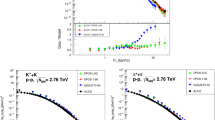Abstract
In a previous study, we compared experimental data of the total and angular differential cross sections of \(\pi ^0\) photo-production off the proton to theoretical models implemented in version 9.6.p02 of the GEANT4 Monte Carlo simulation toolkit (Amar et al. in Eur Phys J A 55:62, 2019). This paper describes a similar work but for the exclusive and differential cross sections of the \(\pi ^+\) photo-production off the proton. The Chiral Invariant Phase Space (CHIPS) and Bertini Cascade (BERT) models were compared to the experimental data from the CEBAF Large Acceptance Spectrometer (CLAS) of Jefferson Lab and the phenomenological Scattering Analysis Interactive Dial-in (SAID) model. Relativistic Breit–Wigner fits were used to compare the description of the nucleon resonance region up to 3 GeV from SAID, CLAS and CHIPS. As observed in the \(\pi ^0\) case, the CHIPS model provides a reasonable description of the invariant mass distribution while the limited tabulated data set of the BERT model is not adequate. Furthermore, the \(\gamma p \rightarrow n\pi ^+\) differential cross sections \(d\sigma /d\Omega \) show significant differences between CHIPS and both CLAS and SAID data pointing to some needed improvements in its physics.









Similar content being viewed by others
References
S.B.L. Amar, O. Ka, P. Guèye, Eur. Phys. J. A 55, 62 (2019)
M. Dugger, B.G. Ritchie, J.P. Ball, P. Collins, E. Pasyuk, R.A. Arndt, W.J. Briscoe, I.I. Strakovsky, R.L. Workman, G. Adams et al., Phys. Rev. C 76, 025211 (2007). arXiv:0705.0816
M. Dugger, B.G. Ritchie, J.P. Ball, P. Collins, E. Pasyuk, R.A. Arndt, W.J. Briscoe, I.I. Strakovsky, R.L. Workman, M.J. Amaryan et al., Phys. Rev. C 79, 065206 (2009). arXiv:0903.1110
S.J. Brodsky, V.D. Burkert, D.S. Carman, J.P. Chen, Z.F. Cui, M. Döring, H.G. Dosch, J. Draayer, L. Elouadrhiri, D.I. Glazier et al., Int. J. Modern Phys. E 29, 2030006 (2020). https://doi.org/10.1142/S0218301320300064
D.G. Ireland, E. Pasyuk, I. Strakovsky, Prog. Part. Nucl. Phys. 111, 103752 (2020)
D. Rebreyend, Le nucléon dans tous ses états. Etude de la spectroscopie du nucléon via la photoproduction de mésons (2006). https://tel.archives-ouvertes.fr/tel-00153657
M. Srednicki, Quantum Field Theory (Cambridge University Press, Cambridge, 2007)
L. Marleau, Introduction á la physique des particules, Département de Physique, génie physique et optique, Université Laval, Québec, Canada, rédigé avec Scientific WorkPlace (SWP) et composé avec MiKTeX
P. Skands, Introduction to QCD, Searching for New Physics at Small and Large Scales (World Scientific, Singapore, 2013)
V. Crede, W. Roberts, Rep. Prog. Phys. 76, 076301 (2013)
M. Guidal, Ph.D. thesis, Université Paris Sud XI Orsay (1996)
S. Agostinelli, J. Allison, K. Amako, J. Apostolakis, H. Araujo, P. Arce, M. Asai, D. Axen, S. Banerjee, G. Barrand et al., Nucl. Inst. Methods Phys. Res. A 506, 250 (2003)
J. Allison, K. Amako, J. Apostolakis, H. Araujo, P.A. Dubois, M. Asai, G. Barrand, R. Capra, S. Chauvie, R. Chytracek et al., IEEE Trans. Nucl. Sci. 53, 270 (2006)
J. Allison, K. Amako, J. Apostolakis, P. Arce, M. Asai, T. Aso, E. Bagli, A. Bagulya, S. Banerjee, G. Barrand et al., Nucl. Inst. Methods Phys. Res. A 835, 186 (2016)
P.A. Zyla et al., PTEP. 2020(8), 083C01 (2020). https://doi.org/10.1093/ptep/ptaa104
M.P. Guthrie, R.G. Alsmiller, H.W. Bertini, Nucl. Instrum. Meth. 66, 29 (1968)
H.W. Bertini, M.P. Guthrie, Nucl. Phys. A 169, 670 (1971)
P.V. Degtyarenko, M.V. Kossov, H.P. Wellisch, Eur. Phys. J. A 9, 411 (2000)
P.V. Degtyarenko, M.V. Kossov, H.P. Wellisch, Eur. Phys. J. A 9, 421 (2000)
P.V. Degtyarenko, M.V. Kosov, H.P. Wellisch, Eur. Phys. J. A 8, 217 (2000)
B. Krusche, Prog. Part. Nucl. Phys. 67, 412 (2012)
W. Briscoe, M. Doering, H. Haberzettl, I. Strakovsky, R. Workman, Scattering Analysis Interactive Dial-in (SAID). Institute for Nuclear Studies, The Geroge Washington University. http://gwdac.phys.gwu.edu (2021)
The CLAS Collaboration, The JLab Experiment CLAS Physics Database. https://clasweb.jlab.org/physicsdb/intro.html (2021)
V. Mokeev, V. Burkert, D. Carman, L. Elouadrhiri, E. Golovatch, R. Gothe, K. Hicks, B. Ishkhanov, E. Isupov, K. Joo et al., Phys. Lett. B 805, 135457 (2020)
Acknowledgements
We would like to express our deep gratitude to Rolf Ent and Jefferson Lab for enabling this research and providing partial funding for this work. Jefferson Science Associates, LLC operates Jefferson Lab for the U.S. DOE under U.S. DOE contract DE-AC05-060R23177. We thank the Spanish Cooperation (AECID) for the initial partial funding of this work. We are also thankful to José Goity (Hampton University) for invaluable discussions about the pion photo-production formalism, Igor Strakovski (George Washington University) for his understanding of the SAID model and its usage of the CLAS data set, and Pavel Degtiarenko (Jefferson Lab) for his insightful understanding of the CHIPS model. We also would like to thank Dennis Wright (SLAC National Accelerator Laboratory and Geant4 Collaboration Hadronic Working Group Deputy Coordinator) for his critical review of this document. SBLA benefited greatly from participating twice to the Hampton University Graduate Studies (HUGS) summer schools that was made possible by Cynthia Keppel (Jefferson Lab) and Alberto Accardi (Hampton University).
Author information
Authors and Affiliations
Corresponding author
Rights and permissions
About this article
Cite this article
Amar, S.B.L., Ka, O. & Guèye, P. Meson photo-production in GEANT4 for \(E_\gamma =0.225\)–3.0 GeV using the \(\gamma + p \rightarrow n + \pi ^+\) reaction. Eur. Phys. J. A 57, 340 (2021). https://doi.org/10.1140/epja/s10050-021-00640-3
Received:
Accepted:
Published:
DOI: https://doi.org/10.1140/epja/s10050-021-00640-3



